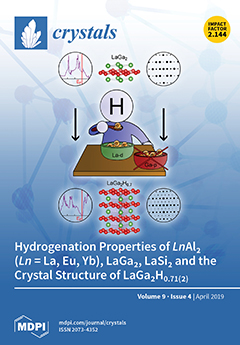We report on the crystal growth of rare-earth pyrosilicates,
Si
O
for
R = Yb and Er using the optical floating zone method. The grown crystals comprise members from the family of pyrosilicates where the rare-earth atoms form a
[...] Read more.
We report on the crystal growth of rare-earth pyrosilicates,
Si
O
for
R = Yb and Er using the optical floating zone method. The grown crystals comprise members from the family of pyrosilicates where the rare-earth atoms form a distorted honeycomb lattice. C-Yb
Si
O
is a quantum dimer magnet with field-induced long range magnetic order, while D-Er
Si
O
is an Ising-type antiferromagnet. Both growths resulted in multi-crystal boules, with cracks forming between the different crystal orientations. The Yb
Si
O
crystals form the C-type rare-earth pyrosilicate structure with space group
and are colorless and transparent or milky white, whereas the Er-variant is D-type,
, and has a pink hue originating from Er
. The crystal structures of the grown single crystals were confirmed through a Rietveld analysis of the powder X-ray diffraction patterns from pulverized crystals. The specific heat of both C-Yb
Si
O
and D-Er
Si
O
measured down to 50 mK indicated a phase transition at
1.8 K for D-Er
Si
O
and a broad Schottky-type feature with a sharp anomaly at 250 mK in an applied magnetic field of 0.8T along the
c-axis in the case of C-Yb
Si
O
.
Full article





